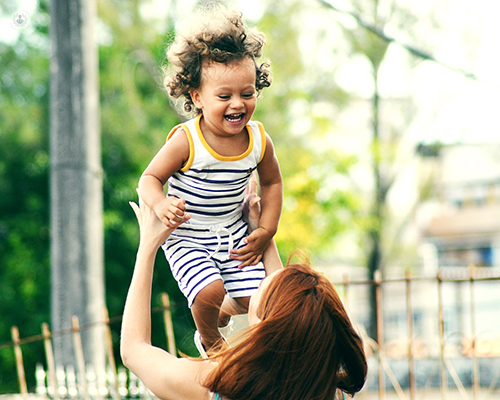Daytime wetting in children: how can this be resolved?
Written by:What causes daytime wetting in children?
Day time wetting is an incredibly common condition in children. They usually attain continence by two to three years old, after potty training, where the parents remove the nappy and the child knows when they need to go to the toilet for a wee.
Typically speaking, daytime wetting often occurs in children who have previously been continent, who have gotten out of nappies, and then start to wet around the age of four or five.
There are two groups of children who wet. The first group is children who are dry and then begin wetting again, known as secondary wetting. The second group is children who have never been dry; they can’t get out of nappies. This is referred to as primary wetting.

Typically speaking, there are different causes to these issues.
Secondary wetting is usually caused by an increase in the obligate volume of urine being produced as the child gets older. The bladder fails to accommodate and stretch to match the volume of urine that is being produced.
What happens is that a child will typically start to get urgent and need the toilet at the last minute and on the way to the toilet they will often wet and have an accident. Sometimes they just do it without knowing but typically it’s associated with urgency. This is extremely common.
With regard to children that never get out of nappies and are wet all the time, there may be another issue, such as an issue with the nerves. It is tied in very closely to bowel function as well; whether they’ve attained stool control. It is also related to night time wetting.
If the child is particularly urgent and has an urging continence, they typically have night time wetting as well because the bladder is overactive, both day and night.
Can lifestyle changes help alleviate symptoms of daytime wetting?
Lifestyle changes can help if the issue is secondary wetting. The first thing that doctors suggest is is lifestyle changes, which includes regular toileting and eliminating any constipation but mainly, getting them to drink plenty.
If children have got bladder overactivity with daytime wetting, it often is associated with nightime wetting.
When daytime wetting is cured, nightime wetting often follows. However, this is not always the case and the nightime wetting may need treating seperately.
What are the treatment options available for daytime wetting?
In secondary wetting, the bladder is poorly compliant. The urine fills and is overactive and twitchy. It will be quite unstable, active and wet. The principle is to increase the capacity and compliance i.e. the stretchiness of the bladder and we do this in one of three ways.
The most basic form of treatment is conservative therapy. In other words, no medicines or surgery is involved. Conservative therapy includes good toilet training and good habits but particularly drinking plenty of water.
Drinking more water is important. Typically these kids won’t drink as much because they know they might wet therefore they redue how much they’re drinking.
They need to drink plenty of water, depending on their age. The doctor will be able to tell them how much to drink. Doing this can, on its own, stretch the bladder. As a result, the child will reach a position where they only go to the toilet every 2 ½ - 3 hours. This is what doctors aim for; timed voiding.
If this is not successful, doctors will try medical therapy. Before doing that, they will take an ultrasound scan of the child’s renal tract and bladder, in order to determine whether they are feeling desperate. Doing an ultrasound means doctors can get an indication of the volume in the bladder and confirm if they’re holding less.
Medical therapy will also confirm whether they’re emptying their bladder properly. This links with daytime wetting, which may be neurologically based.
If doctors confirm that children are emptying properly and confirm the diagnosis of an overactive bladder, doctors can prescribe a medicine from a group of medicines named antimuscarinics. Oxybutynin is usually the first option.
These medicines relax the muscle of the bladder but also have some other effects. They affect the salivary gland, can cause a dry mouth and also cause constipation. They are the main side effects of these medicines.
Oxybutynin can be used for a period of six months, with a review at three months. For the majority of kids, it’ll relax their bladder and when they’re drinking more, it’ll stretch it. They will increase their capacity and compliance, so that they can hold more for longer and can last 2 ½ /3 hours without needing to go to the toilet. This cures the problema and the medicine can be stopped.
If that doesn’t work, in resistant cases, doctors may prescribe another, similar medicine, or change the medicine and try again. Some people need prolonged, different therapies to do the job.
In some cases, they’re resitant to all medical therapies. Doctors typically consider urodynamics, which is a the test that we do to physically measure the pressure in the bladder. If that confirms the problema, they doctors will consider surgical options.
They usually put the child to sleep, insert a camera and inject the bladder with botox. The botox paralyses the bits of muscles and allows it to relax so it can stretch.
In extremely rare cases, there are children who don’t respond to anything and some of those will overlap into the neurological type. If that is the case, doctors will consider imaging the spine.
They do an MRI of the spine and they do this for kids who have never been dry. MRIs ensure that the doctor has not missed spina bifida occulta or something similar.
Should parents be concerned that daytime wetting could be a symptom of a larger medical condition?
It is important to stress that the vast majority of children with daytime wetting, where they’ve been out of nappies and started being urgent and wetting, is common and treatable.
There is some cause for concern when the child has never been dry. Often this is associated with problems with the bowel, either really severe constipation or soiling.
There is also cause for concern when the child is completely unaware that they need to go to the toilet; in cases where parents will find them sitting in a puddle of wee. They have no idea that they’ve had an accident.
This is the second group, referred to as primary diagonal enuresis and requires further investigation. In this case, an ultrasound scan would be mandated and likely an MRI of the spine ensure that there is no spina bifida occulta. That would imply that there is a nerve problem to the bladder and spine.


